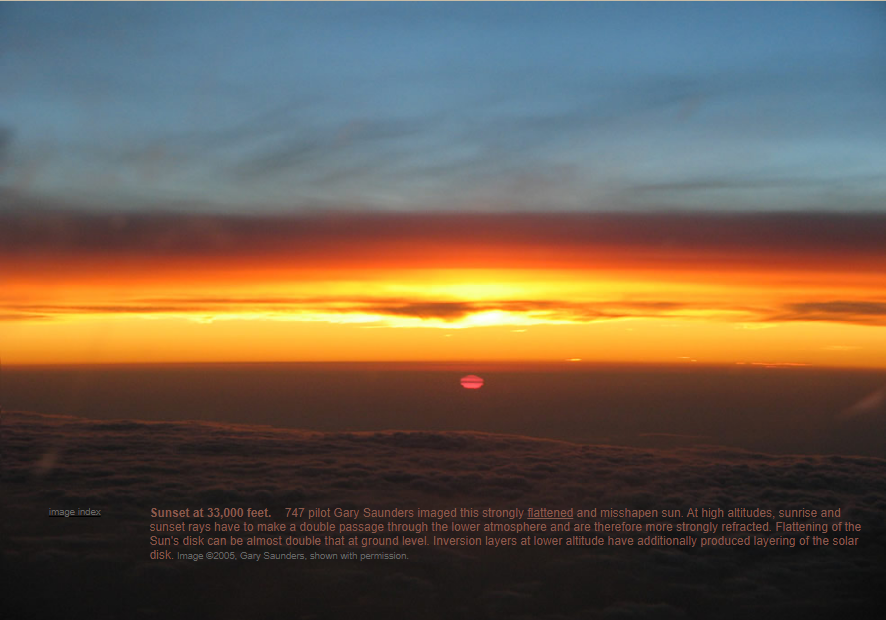33,000 feet sunset
The Phenomenon of Sunset at 33,000 Feet
Have you ever wondered what a sunset looks like from 33,000 feet in the air? It turns out that the view from high altitudes can be quite different from what we see on the ground. The sun appears strongly flattened and misshapen, creating a unique and captivating sight. In this article, we will explore the phenomenon of a "33,000 feet sunset" and delve into the science behind its appearance.
Refraction and the Flattening Effect
At high altitudes, such as 33,000 feet, the rays of the sun have to pass through the lower atmosphere twice during sunrise or sunset. This double passage through the atmosphere causes the sunlight to undergo stronger refraction compared to when observed from ground level. As a result, the shape of the sun's disk becomes significantly flattened, almost double that of what we perceive from the surface.
Layering and Inversion Layers
In addition to the flattening effect, another fascinating aspect of a sunset at 33,000 feet is the presence of layering in the solar disk. This layering occurs due to inversion layers at lower altitudes. Inversion layers are atmospheric conditions where temperature increases with height instead of the usual decrease. These layers cause light to bend and create distinct layers within the sun's disk, further enhancing its unusual appearance.
The Role of Atmospheric Optics
The phenomenon of a "33,000 feet sunset" falls under the realm of atmospheric optics. Atmospheric optics is a branch of science that studies how light interacts with the Earth's atmosphere and how it influences our perception of celestial phenomena. By understanding the principles of refraction, scattering, and other optical phenomena, we can unravel the mysteries behind captivating sights like this unique sunset.
Capturing the Beauty
Photographers and aviation enthusiasts often seize the opportunity to capture the breathtaking views of a "33,000 feet sunset." With the right equipment and timing, they can immortalize this extraordinary sight. These photographs not only serve as stunning visual records but also contribute to our scientific understanding of atmospheric optics.
Similar Phenomena
The distorted appearance of the sun during a "33,000 feet sunset" is not limited to this specific altitude. Similar phenomena can be observed at various heights, depending on atmospheric conditions and the observer's position. For example, mountain climbers may witness similar distortions when they reach high altitudes. Each observation provides valuable insights into the behavior of light in different atmospheric settings.
Awe-Inspiring Skies
The skies at 33,000 feet offer a captivating experience for those fortunate enough to witness a sunset from such heights. The vivid colors, unusual shapes, and layering effects create a scene that is truly awe-inspiring. It serves as a reminder of the beauty and complexity of our atmosphere and the wonders that can be found even in the simplest daily occurrences.
Scientific Research and Discoveries
Studying phenomena like the "33,000 feet sunset" contributes to ongoing scientific research in atmospheric optics. By analyzing the data collected from these observations, scientists can gain a deeper understanding of the Earth's atmosphere and its interactions with light. This knowledge can have implications in fields such as meteorology, climate science, and even space exploration.
Appreciating Nature's Spectacle
The next time you find yourself aboard an aircraft at high altitudes during sunrise or sunset, take a moment to appreciate the unique spectacle unfolding before your eyes. Observe the flattened and misshapen sun, the layers within its disk, and the vibrant colors painting the sky. Reflect on the scientific principles at play and marvel at the wonders of our atmosphere. The "33,000 feet sunset" is a reminder of the remarkable beauty that surrounds us, even when we are soaring through the skies.

Sunset at 33,000 feet. 747 pilot Gary Saunders imaged this strongly flattened and misshapen sun. At high altitudes, sunrise and sunset rays have to make a double passage through the lower atmosphere and are therefore more strongly refracted. Flattening of the Sun's disk can be almost double that at ground level. Inversion layers at lower altitude have additionally produced layering of the solar disk. Image ©2005, Gary Saunders, shown with permission.
Note: this article has been automatically converted from the old site and may not appear as intended. You can find the original article here.
Reference Atmospheric Optics
If you use any of the definitions, information, or data presented on Atmospheric Optics, please copy the link or reference below to properly credit us as the reference source. Thank you!
-
<a href="https://atoptics.co.uk/blog/33-000-feet-sunset/">33,000 feet sunset</a>
-
"33,000 feet sunset". Atmospheric Optics. Accessed on November 26, 2024. https://atoptics.co.uk/blog/33-000-feet-sunset/.
-
"33,000 feet sunset". Atmospheric Optics, https://atoptics.co.uk/blog/33-000-feet-sunset/. Accessed 26 November, 2024
-
33,000 feet sunset. Atmospheric Optics. Retrieved from https://atoptics.co.uk/blog/33-000-feet-sunset/.